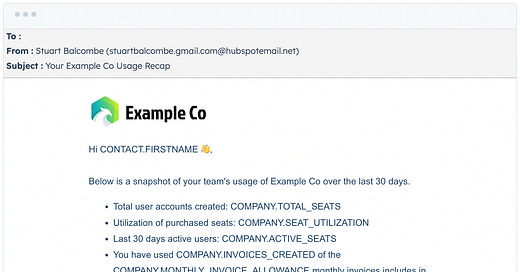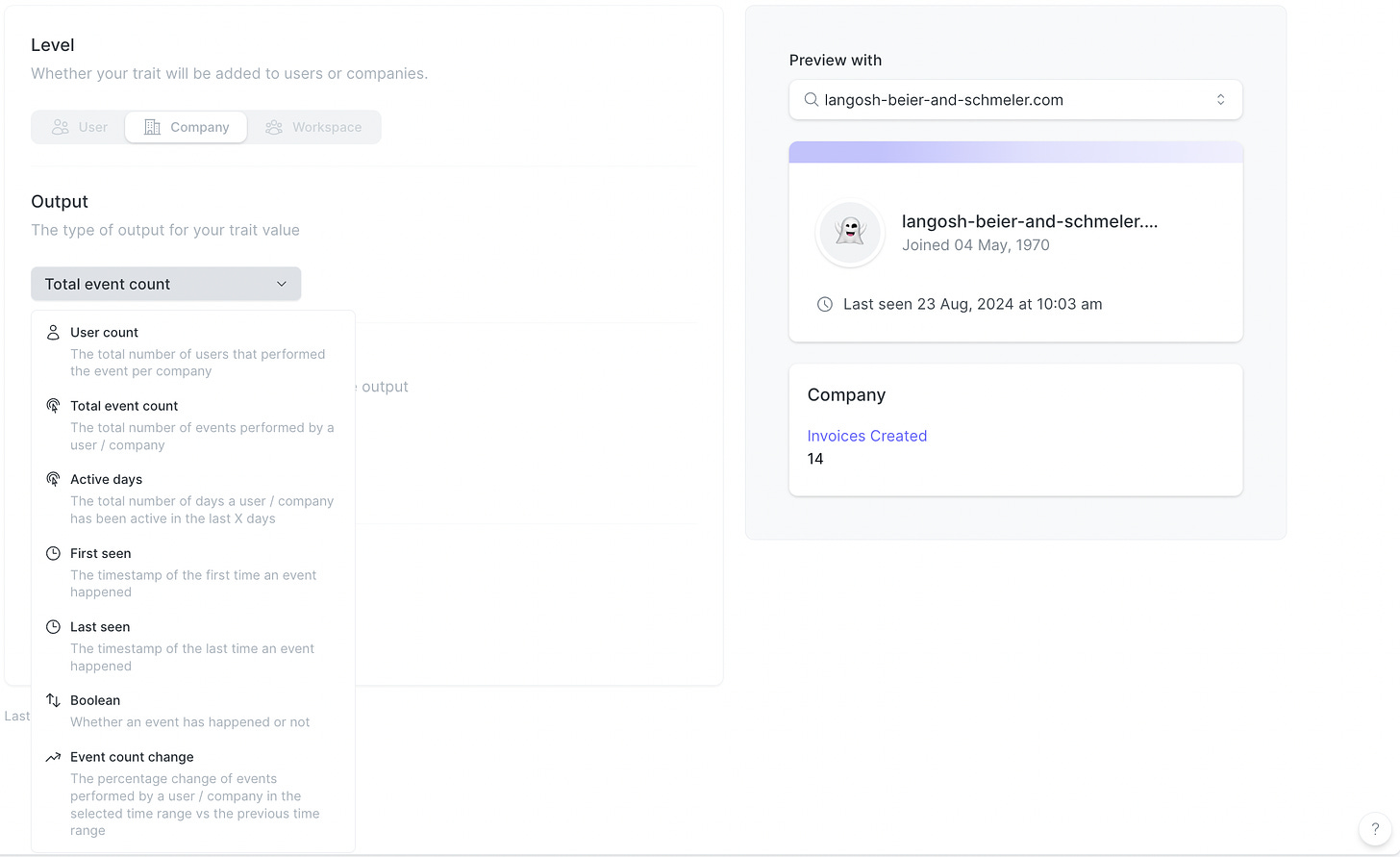How To Drive Expansion With Product Usage Data in HubSpot
Turn your product data into an automated sales tool.
👋 Hey, Stuart here. Wanted to give a warm welcome to the 141 new ConnectedGTM readers who joined since last week!
There’s a lot of talk about onboarding and renewal management in customer success.
But what about the long stretches between QBRs or other scheduled “touches”.
Do you have a way to check how a customer is tracking against expectations?
Does your customer have visibility into their progress against expectations?
By integrating product usage data in HubSpot, we can solve for 2 core cases where a clear understanding of expected use vs reality of use is critical:
Customers pay per seat (or are limited by number of seats) and need to know how many seats they’ve assigned AND how many are being actively using.
eg. Customer’s plan includes 5 seats, 4 users created but only 2 are active.Customers pay for consumption. Either via plan limits or credits.
eg. Customer’s plan includes 50 invoices per month and has sent 53.
In both cases knowing the utilization rate at any point in time can inform how we engage and align on a success plan with the customer.
That’s what we’re covering today. Let’s dive in.
Integrating product usage data in your HubSpot portal makes it possible to create powerful new views, workflows, and reports based on the actions users are taking in your product.
But, any type of data integration can seem technically daunting and time consuming to implement. Let’s unpack the different approaches to integrating product data you might take and highlight questions you should ask before getting started.
At the highest level there are 2 distinct ways to represent product data in HubSpot:
Custom Properties - capture a snapshot of your product usage at a single moment in time. Eg. the number of invoices that have been created.
Custom Events - capture product events for each instance of a product interaction. Eg. each new invoice created.
Integrating product data with HubSpot custom events or custom properties can be a viable path as both can be used to power reporting and automation.
However, to make product usage most actionable for your customer success and account management teams you’ll want access to computed information about product events to help answer questions about an account.
For example: How many invoices have been created in the last 30 days?
This is where many 3rd party data tools can help, by adding the ability to compute combinations of individual product events into a single property value that is synced to HubSpot.
Here’s an example of how product analytics tool June.so enables users to create computed traits based on events.
Solutions For Integrating Product Data With HubSpot
The specific method you use for integrating product data in HubSpot will likely depend on the specific tech stack you use, the volume and types of product data you would like to integrate, and the level of technical integration you are ready to take on.
Category 1: Reverse ETL
Hightouch - Syncs data from your data warehouse (or production app database) directly into HubSpot and other tools. The no-code interface allows you to define data models via SQL queries or visual selectors, which can be a helpful if you don't have a dedicated engineering team.
1000+ HubSpot installs | Free to get started | Integrate with any object
Census - Allows you to sync your internal customer data directly to HubSpot, enabling more targeted and personalized campaigns. Real-time data sync capabilities, supports various triggers, and provides robust monitoring tools.
1000+ HubSpot installs | Free to get started | Integrates with Companies, Contacts, Deals, and Events
Integrate - Enables a 2-way data connection that can extract data from HubSpot for analytics & reporting or load data to HubSpot for building a centralized customer 360 view. Flexible choice for integrating complex data environments without extensive coding.
Credit based pricing
Syncari - Extends beyond traditional reverse ETL by offering continuous data synchronization across your data warehouse and business applications. Well suited for maintaining data quality and governance across multiple platforms
100+ HubSpot installs | Starts at $4,995 | Integrates with Companies, Contacts, Deals, Tickets, and Events
Category 2: Product Analytics Tools
June.so - In-depth usage analytics for product-led growth, sales, and customer success that can be directly integrated into HubSpot for customer segmentation and personalized marketing. Built on top of Segment with computed traits make it a flexible solution that can be implemented by less technical teams.
200+ HubSpot installs | Free to get started | Integrates with companies + contacts
Amplitude - Powerful product analytics tool that allows you to track user interactions with your product, providing detailed insights on user behavior and use them to refine customer journeys and enhance marketing efforts by streaming events to HubSpot.
500+ HubSpot installs | Free to get started | Integrates with custom events
Mixpanel - Two-way sync available that shares data in real time. Historical data sync automatically updates HubSpot records right away, and updates future events as they happen.
500+ HubSpot installs | Free to get started | Integrates with contacts
Category 3: Custom Event Integrations
Segment - Customer data platform that allows you to collect, clean, and control your data, sending it to HubSpot and other tools you use. Segment can act as a single source of truth for your customer data to streamline integrating it with HubSpot.
1,500+ HubSpot installs | Free to get started | Integrates with Companies, Contacts, Deals, Tickets, and Events
HubSpot Web Analytics - HubSpot’s native web analytics tools can be used to track customer behavior on your website and/or in your product. It’s not as specialized as the other tools listed but does enable capturing basic product usage data and integrating it with HubSpot.
Free
Webhooks - For more technical teams, webhooks are a powerful way to send real-time data from your product to HubSpot. Flexibility to integrate virtually any type of product data.
Whichever method you choose for integrating product data, what’s most important is how you make it actionable for your customer-facing teams.
Step-by-step driving usage based expansion with product usage data
Increasing revenue (and all important revenue retention metrics) in a usage-based pricing model requires a deep understanding of how your users interact with your product.
Using our product usage data, we can identify high-value customers, personalize outreach, and strategically target users who are most likely to upgrade.
In this example we are going to use a 2 pricing variables to calculate account utilization:
Number of Seats
Number of Invoices Created
Here’s how it works step-by-step:
Keep reading with a 7-day free trial
Subscribe to ConnectedGTM to keep reading this post and get 7 days of free access to the full post archives.




